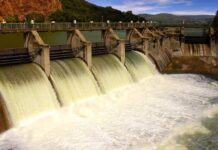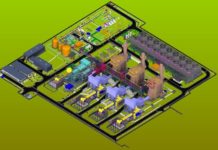Barseback Unit One ceased operation on 30 November 1999 following an agreement between the Swedish government and Sydkraft, the plant’s owner. This shut down followed 23 years of operation, 17 short of the planned life expectancy for the plant.
“The plant will finally be demolished in 2020, when a storage facility has been built.”
The owning subsidiary Barsebรคck Kraft AB was merged with Ringhals AB (the owning subsidiary of the Ringhals nuclear plants and part of Vatenfall) into a single corporate group in which Vatenfall owned 74.2% and Sydkraft 25.8%.
Barseback Two was closed on 31 May 2005. The plant will finally be demolished in 2020, when a storage facility has been built.
FOUR YEARS OF SINGLE OPERATION
Sydkraft challenged the closure of Barseback One with a complaint to the EC. The government compensated the joint company for the additional costs incurred for “single operation” of the Barsebรคck Two plant, and decommissioning and service costs for Barseback One.
This compensation was to be paid annually to the new group in the form of an initial sum of SEK 400m, which would be gradually reduced to approximately SEK 240m in the final year. The cumulative payments for Barseback One were originally thought to be SEK3.3bn, but the World Nuclear Association reports that the figure rose to nearly SEK6bn (โฌ600m).
Barseback Two was also closed early, however. In October 2004 the Swedish government ceased negotiating with the utilities, and closed Barseback Two in May 2005. Ringhals reportedly received a similar amount in compensation as for Barseback One. The last fuel shipment to interim storage was made late in 2006. Fuel decontamination of both units is planned for 2007 and 2008.
Sweden is replacing the lost 8.5TWh/yr of nuclear output by importing largely coal-fired energy from Denmark and Germany, and nuclear energy from Finland and Russia.
BARSEBACK OWNERSHIP
From 1 December 1999, a new agreement between the government, Vattenkraft and Sydkraft came into effect. The agreement granted Sydkraft ownership of 25.8% of Ringhals, thereby guaranteeing Sydkraft the equivalent amount of electric power from the four Ringhals and single remaining Barsebรคck reactor as was previously produced by the two Barseback reactors.
The new corporate group, Ringhals and its Barseback subsidiary, had a total effect of 4,230MW, of which Sydkraft would dispose of 1,055MW.
HIGH ENERGY CONSUMPTION IN SWEDEN
Electricity consumption in Sweden is one of the world’s per-capita highest. Energy supply is around half hydro and half nuclear. Barseback originally came into operation in 1975 and 1977, with two of 12 reactors in the country. In a referendum in the country in 1980, the Swedish people voted to continue running existing plants until they were due to close. The Swedish Parliament voted to stop any more nuclear power expansion, and to try to decommission the country’s 12 existing plants by 2010.
In September 2006, a pro-nuclear coalition led by the Conservatives took power in Sweden. They decided to upgrade several reactors. There is also now some discussion about building new reactors after 2010.
“Sweden is replacing the lost 8.5TWh/yr of nuclear output by importing largely coal-fired energy from Denmark and Germany, and nuclear from Finland and Russia. “
ELECTRICITY OUTPUT
The close-down of the Barseback Two reactor had a political prerequisite, namely that its electricity output of 4โ€“4.5TWh either be replaced by renewable energy or saved. Savings and grants accounted for somewhat in excess of 1TWh, but actual results, which are not accounted, were around 0.5TWh.
In spite of a relatively high production of electricity during 1999, Sweden imported some 8.4TWh of electricity, mainly produced in fossil fuel plants. During spring, the Department of Industry will commission a non-partisan evaluation of the restructuring programme.
Barseback Two was originally planned to remain in operation until at least 2017.













































